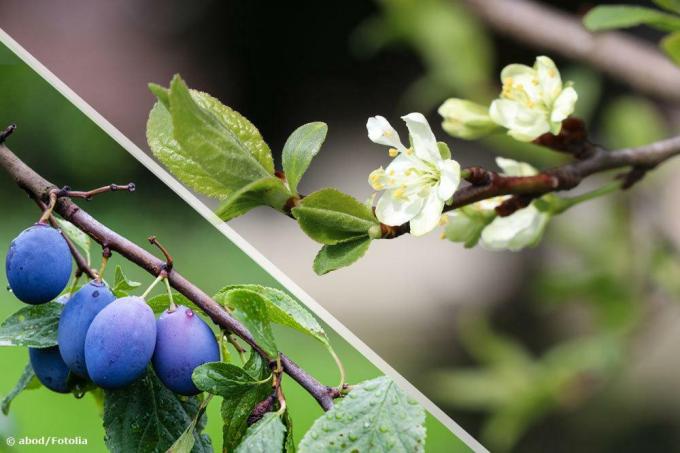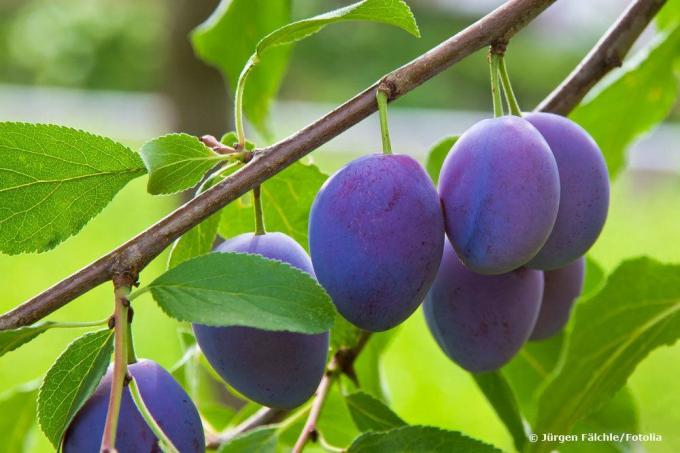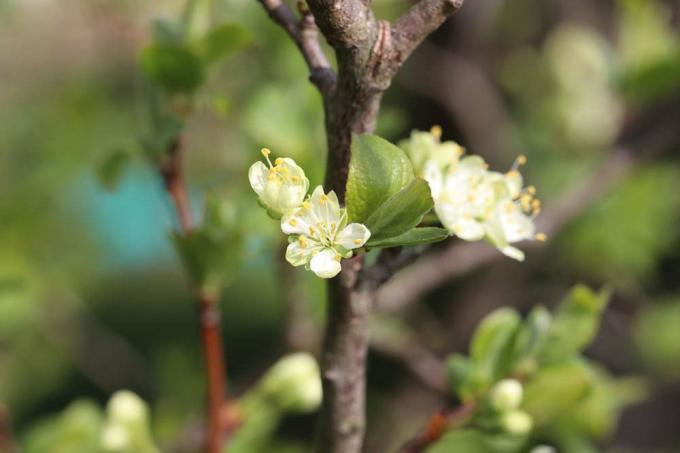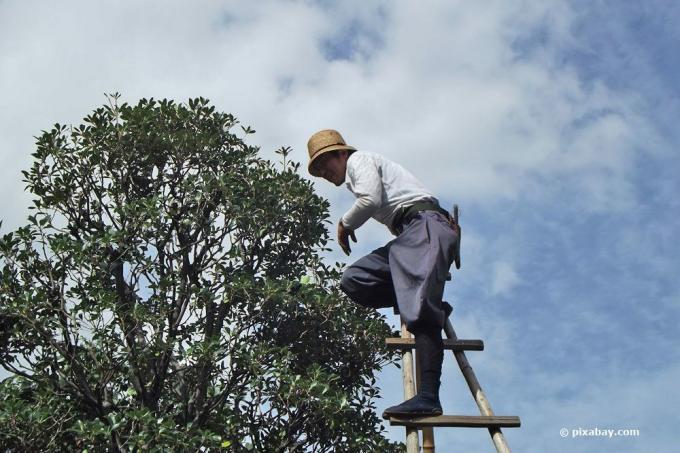
table of contents
- Cut the plum tree
- First cut after planting
- Upbringing
- Conservation cut
- Taper cut
- Divert branches
- Right tool
- Best time
So that the fruit shoots of the plum tree do not grow old and the yields decrease, the fruit needs regular pruning. The trees grow naturally with a narrow crown and upright, the fruits, however, usually form inside the crown. But not only the real plum trees, also mirabelle plums, reenclods or plums receive the same pruning for the productivity. The following article explains how to ideally proceed with the cut and when is the right time for the different cuts.
Cut the plum tree
As with any pome fruit, the structure of the crown should also be built up with the plum. This includes not only the right plum trees, but also mirabelle plums, renekloden and plums, all of which can be given the same cut. In all types of plums, the flower buds are formed on the biennial and perennial branches. Only a few new varieties have the property that the flowers are already forming on the annual shoots. After about four to five years, the fruit wood is exhausted and begins to age. Suitable pruning measures stimulate the formation of new fruit wood. However, a plum tree does not tolerate large cuts and should therefore be annually
cut back will.First cut after planting
If the plum tree is planted in late autumn or early spring, it should not be pruned. The first cut is then always made in next spring after planting. The structure of the crown is then built up so that the plum can later form its fruit on the fruit branches. You should proceed as follows:
- select a vertical central shoot
- leave this one
- Shorten to the same height with side shoots
- Let four side shoots stand
- Make sure that the distance is as even as possible
- Shorten side shoots by a third
- should become the later main branches
- always shorten to one eye pointing outwards
- remove all other shoots
Upbringing
In the further years after planting, the plum tree then needs the training pruning, which keeps the crown in shape before the first fruits are borne. All plum trees try so-called Competitive instincts to form the leading instincts. However, these should be removed regularly. Otherwise the crown will be too dense on the inside, but the fruits that are forming on the inside of the fruit shoots will not get any light to develop properly. The following must also be taken into account when it comes to the upbringing:
- Ideally in May or June
- then annoying, green shoots can be removed
- these are waterfalls
- no fruit shoots
- take the tree's strength to form blossoms and fruits
- alternatively, of course, also possible in early autumn
- cut all competing shoots over the summer
- Leave around eight shoots per guide branch
- should grow outwards
- Cut back the shoots inside to about 10 cm
The eight shoots remaining on the main branches should now be shortened to half of their previous year's growth in spring. Always cut directly over an outward-facing eye. If the plum tree is older, you only have to carry out the maintenance pruning, as the crown already has the correct shape with a regular annual pruning.
Conservation cut
The best time for maintenance pruning is in the summer after the harvest. For this purpose, the fruit and scaffold shoots located in the crown are thinned out. In this way, the shape and size of the plum tree can be preserved. The procedure is as follows:
- remove all steep shoots
- remove all shoots growing inside the crown
- Cut back the competing shoots on short tenons
- Leave biennial shoots with buds
- Remove worn and hanging fruit shoots
- Shorten all guide branches to the required length
- specify the shape and size of the crown
- Leave the central shoot about 20 cm longer than the leading branches
You can also carry out the maintenance pruning in autumn, when the plum tree has already lost its leaves. When you cut depends primarily on the weather on the day of cutting. The purpose of pruning the plum in autumn is so that the shoots to be cut are easier to see on a bare tree than on a leafy tree.
Taper cut
You should only carry out a rejuvenation pruning if the plum tree has not been pruned for several years. One Avoidance however, this cut is always better. But this is not always possible, for example when a garden with an older plum tree has been taken over and it has not been maintained in recent years. For the taper cut you should then proceed as follows:
- cut all steep shoots
- not too many cuts on a guide branch
- if in doubt, leave ten centimeters long cones
- after two years remove the cones directly from the trunk
- derive aged and overhanging shoots
- on younger shoots within the crown
- Shorten aged branches down to younger side shoots
Divert branches
When pruning the plum tree, annoying branches inside the crown are often diverted. This applies above all to the steeply growing branches. Then that branch is diverted to a branch that grows flatter. In this way the crown opens and more light and sun reaches the plums inside. The procedure for deriving is therefore as follows:
- Cut off the tip of the main branch directly above the side shoot
- so the side shoot is preserved
- grows outwards
- The main branch is retained
- no longer grows upwards but flat
Right tool
The right tool is important so that Prunus domestica is not damaged and continues to bear its tasty fruits. So for each pruning of the plum, you will need the following tools:
- Branch saw for thick branches
- Loppers for thinner shoots
- Secateurs for thin branches
- everything should be clean and disinfected
- otherwise bacteria, viruses or fungi adhere
- transferred via wound to tree
- only use sharp tools
- Otherwise the interface could fray
- good possibility for bacteria, viruses or fungi
- Use wound wax for large interfaces
With tall trees you will also need a ladder to get to the crown of the plum. In order for it to have a beautiful shape, it is also useful to work in pairs, because standing on the ladder can quickly lose track of the shape. A second person can then provide advice from below.
Best time
Since Prunus domestica has to receive different pruning for upbringing, maintenance and rejuvenation, the annual pruning times are very different. But whether you want to cut back in summer, spring or autumn, the following should always be observed:
- in autumn and spring on frost-free days
- otherwise frost could penetrate the interface
- the tree is damaged
- anytime on an overcast and dry day
- The sun dries out the interfaces too much
- could burn this
- rain pulls in moisture through the interfaces
- Fungi, bacteria and viruses spread more easily
- can get into the tree directly through the wound



